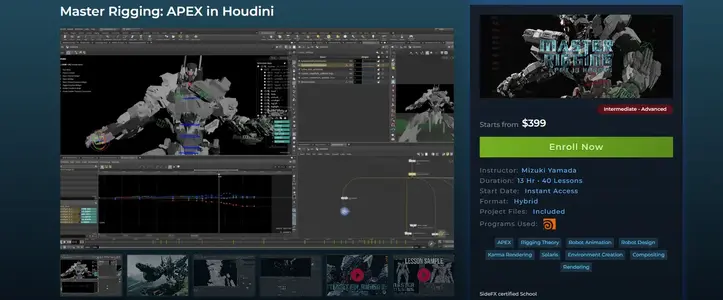- Sep 26, 2025
- 25
- 4
Master Rigging: APEX in Houdini is an advanced workshop by Double Jump Academy led by industry artist Mizuki Yamada. It teaches procedural rigging of transforming robotic assets using Houdini’s APEX framework, along with integration of animation, environment, and rendering workflows.
Introduction
This workshop from Double Jump explores APEX rigging—Houdini’s modern procedural component-based rigging system—through the lens of robot transformations. Rather than rigging organic characters, the focus is on mechanical motion, constraints, and animation control using nodes and components. The course is designed for intermediate to advanced users who already understand Houdini fundamentals.
Workshop Highlights
The workshop spans about 13 hours divided into 40 lessons Students are guided from basic APEX setups to rigging a complex transforming robot asset along with animation workflows Additional coverage includes terrain creation, materials, lighting, rendering in Houdini’s Solaris/Karma, and compositing insights The course also shows how to bridge Maya locators to Houdini rigs if needed
Why This Course Stands Out
Unlike courses that focus purely on character skin rigs, this class specializes in mechanical rigging using APEX which is suited to robots, vehicles, and transforming structures The instructor shares real studio workflows Used components include scene nodes like sceneaddcharacter sceneinvoke and sceneanimate The procedural approach allows non destructive changes and modular rig parts
Practical Applications
With this workshop you can rig transforming robots in films or games build animatable mechanical props integrate rigged assets into scenes or virtual production pipelines Use APEX rigs to drive animation, blending, or transformations between modes (vehicle to robot) Combine rigged assets with environment and lighting projects for full shots
Ease of Learning
Though the course is labeled intermediate to advanced, clear examples are provided to explain the core principles of APEX, component rigging, and procedural constraints Early lessons cover simple transforms and then build up to full robot rigs The modular teaching helps learners digest complex systems step by step Sample project files are included to follow along
Expert Review
Master Rigging: APEX in Houdini is a niche but powerful workshop. Its depth in mechanical rigging makes it highly relevant for artists working on sci-fi, robotics, or transforming assets The mixture of animation, lighting, and compositing topics adds value beyond pure rigging It demands familiarity with Houdini nodes, VEX, and pipeline thinking
Quick Insights
This course empowers riggers to build robust procedural APEX rigs, animate transforms, and integrate them into full visual scenes The modular rigging philosophy supports flexibility and iteration across projects
Learn More & Explore: Official Reference
Frequently Asked Questions
Q1 What prior skills do I need?
A1 You need basic to intermediate Houdini knowledge, comfort with nodes, VEX or VOP, and rigging concepts
Q2 Does it cover organic character rigs?
A2 No, the course is focused on mechanical and transforming robot rigs not skin deformation
Q3 Are project files included?
A3 Yes, students receive project files to follow along with the lessons
Q4 Will I learn compositing and lighting too?
A4 Yes, additional lessons include terrain, lighting, rendering in Solaris/Karma, and compositing workflows


